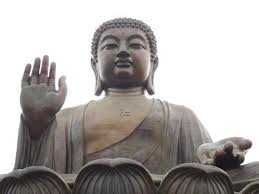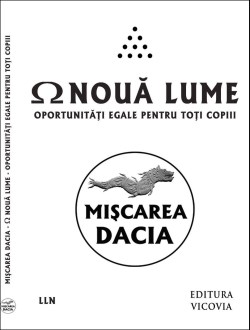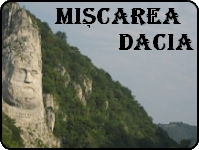 Vă invit să vă alăturaţi grupului Facebook Mişcarea DACIA, ce-şi propune un alt fel de a face politică!
Vă invit să vă alăturaţi grupului Facebook Mişcarea DACIA, ce-şi propune un alt fel de a face politică!Citiţi partea introductivă şi proiectul de Program, iar dacă vă place, veniţi cu noi !
O puteţi face clicând alături imaginea, sau acest link
Posts Tagged ‘Dante’
Hyperian History Of The World (17th Century, Part 3)
Noutăţi
Hyperian History Of The World (17th Century, Part 3)
The 17th Century also saw major developments in the arts. If the focus of the renaissance had been on the visual arts of painting and sculpture, matching and surpassing the visual style of ancient Greece and Rome, the 17th century saw truly innovative ideas in both Literature and Music.
Music had, of course, since prehistoric times, been used for both entertainment as well as for spiritual and religious purposes. Whilst all manner of folk traditions existed, featuring traditional instruments accompanying the singing of songs, the religious power of music had been recognised by the catholic church and, over the centuries, a kind of formalisation of music had occurred.
Catholic monks had begun singing excerpts of the bible using simple melodies. The singing was unaccompanied, as the human voice was considered the only pure instrument. Eventually, monks developed techniques of harmony and counterpoint to increase the complexity as well as the beauty of their singing. Crucially, a system had been developed where music could be written down and thus the same pieces could be performed by different musicians and preserved for ever. Eventually composers began to study music to high levels and produce beautiful works of polyphony, yet nearly always for religious purposes, such as musical settings of the catholic mass, always for unaccompanied singers. By the renaissance, this kind of music reached its greatest heights in the work of composers such as Giovanni Palestrina, in Italy.
Yet in the 17th century, the ambitions of composers would reach greater heights. The universality of renaissance art, as well as the literary move away from the religious language of Latin towards the vernacular languages (since Dante), had led to the idea of high art for ordinary people, not just for religious purposes but neither simply for entertainment. The same thing was to happen with music, chiefly through the most significant development of the 17th century – Opera.
Opera became, arguably, the most important artistic synthesis since ancient Greek tragedy. An opera was a theatre performance, yet the performance was entirely accompanied by music and all the dialogue was sung rather than spoken. Rather than the sombre church singing of renaissance religious compositions, opera was exciting, vibrant and energetic. Singers were accompanied by larger ensembles of instruments creating a bigger, more vibrant sound. An opera was a grand spectacle, featuring music, poetry, drama, as well as visual elements.
The earliest opera which is still performed today is L’Orfeo composed in 1607 by Claudio Monteverdi, perhaps the most important composer of the 17th century. L’Orfeo tells the story of Orpheus and his journey into the underworld to retrieve his beloved Eurydice. This was an ancient pagan myth, rather than a christian story, which tells us that, right from the start, opera placed itself apart from the dogmatic reach of the church. Nonetheless, Monteverdi also composed works that were more ostensibly christian, such as his Vespers of 1610, based on catholic texts. Yet unlike the unaccompanied vocal works of the renaissance, Monteverdi’s Vespers are performed by a large choir accompanied by a large orchestra of various instruments, strings, winds, brass and percussion. This signalled the move into a new musical era known as the Baroque. Much like the religious paintings of the renaissance, Baroque music, even when based on christian texts, has a certain universality to it, transcending the confines of the church and reaching greater spiritual heights.
Monteverdi was merely the beginning, and music would attain to greater heights in centuries to come, but the 17th century also saw a boom in literature. Whilst poetry had dominated for centuries, in Spain Miguel de Cervantes established the basis for the modern novel with Don Quixote, and in England William Shakespeare wrote some of the finest plays the world has ever seen, with his ability to take command of the English language and push it to poetic heights matching any classical literature.
Centuries earlier, Dante had shown how epic poetry written in one’s vernacular could attain glorious heights, and in the 17th century another epic masterpiece appeared in a similar vein. This was Paradise Lost by the english poet John Milton. Like Dante’s Divine Comedy, Paradise Lost is an epic poem which tells a christian story, yet one can’t help but detect a certain gnostic undercurrent to the narrative, despite Milton’s being a puritanical protestant.
The poem tells the story of the aftermath of Satan’s rebellion against god and his subsequent tempting of Adam and Eve in the garden of Eden leading to the fall of man. Milton focuses far more on Satan than on the other characters and, rather than presenting him as a great evil, Milton seems to present him as a tragic character whom the reader might sympathise with, a sort of anti-hero. Satan becomes a kind of revolutionary, leading a rebellion against the tyranny of god in heaven. As such, Satan comes across much more like the heroes of ancient, pagan mythology, and the poem forces the reader to engage in questions on the very nature of god and Satan and how they are presented in the conventional christian narrative. Such questioning can easily lead to the conclusions drawn by the ancient gnostics, that it is in fact the christian god who is the true Satan, and Lucifer who is a being of Light who freed humanity from god’s tyranny. This may not have been Milton’s conscious intention, yet the poem seems to channel certain archetypal ideas which lead one back to the pagan mythology of old, and away from the confining christian dogma.
The 17th century saw humanity moving towards an era known as the Age of Enlightenment and saw radical departures from the tyranny of the church with the world seeming to finally be moving back towards rational philosophy and pagan spirituality. Pure philosophy, devoid of christian content had reappeared, science was tearing apart the worldview of religion and human creativity was booming once again with ambitions matching and surpassing the glory of antiquity. Humanity had, for so long, been ignorant under the tyranny of the christian god, but now, following the example of Eve, they were once again feasting on the fruit of the tree of knowledge. As ‘Satan’ says in Paradise Lost, “Knowledge forbidden, Suspicious, reasonless. Why should their Lord Envy them that? Can it be a sin to know? Can it be death?” The enlightenment answers, “Aude Sapere” – Dare to Know!
Hyperian History Of The World (14th Century, Part 2)
Hyperian History Of The World (14th Century, Part 2)
At the start of the 14th Century, with the might of the Catholic church at its full strength having exterminated the Cathars and brought down the Knights Templar, it may seem as though the Dark Ages had become darker than ever. Yet the resurgence of Gnostic resistance was the prelude to the great rebirth of human brilliance, creativity and philosophy known as the Renaissance. But before that great age began proper, a single great work of human creativity appeared in the world showing beyond doubt that all was not lost. Ancient Greece had given to the world the great poems of Homer and Rome had bestowed upon us Virgil and Ovid, yet after the end of antiquity it seemed as though such literary brilliance would never again grace the world. Until, that is, a new artistic genius appeared in the world, in Italy, the great poet Dante Alighieri, who wrote one of the most magnificent literary creations the world has ever seen, his Divine Comedy.
Catholic philosophy had reached its zenith at the end of the previous century in the work of Thomas Aquinas, and that philosophy/theology was a major influence on Dante, who was a Catholic, yet Dante did something far greater. He created an artistic creation of great imagination which nonetheless remained a work which presented all the knowledge of the world which was available at the time. Like Aquinas, Dante was influenced by Greek philosophy as much as by Catholic theology, and his poem contains references to and characters from both biblical sources and classical mythology. Dante presents the entire cosmology of the universe as it was known at the time. He journeys through the universe as it was understood to be in that age, describing it all in wondrous detail and yet also presenting a spiritual undertaking, a sacred quest from the depths of ignorance and despair to the heights of knowledge and transcendence.
Dante’s description of the universe is ostensibly in complete accordance with catholic dogma, yet it contains so many references to the pre-christian mythology of antiquity that it becomes difficult to see the Divine Comedy as a purely christian work. Dante seems to straddle the border between christianity and classical paganism, between the submission of catholicism and the heretical yearning for knowledge of gnosticism. The comedy is also a perfect union of mythos and logos, as it presents the cosmology and philosophy of the time but told through poetry, rich in symbolism and beauty.
Never before had an artist so wonderfully presented all of the knowledge of their time in a single work of creative majesty. Dante describes the cosmological view of the universe as it was known in his time. He begins his journey by delving deep into the earth under which is located Hell itself. Dante descends lower and lower through the circles of Hell until he reaches Satan himself in the deepest pit at the very centre of the world. Following this, Dante comes through to Mount Purgatory, which rises up away from Hell but on the southern Hemisphere of the earth. At the summit of this mountain is located the Garden of Eden and after this, Dante begins his journey upwards through the crystal spheres of the heavens getting closer and closer to the divine until he reaches the very top, the highest level, the Empyrean where Dante engages in the Beatific vision, the union with the Divine itself.
The poem is split into three major sections, Inferno (Hell), Purgatory and Paradise. Each of these three realms is further divided into nine circles, with a final level each time bringing the total to ten, these final levels being, firstly, the realm of Satan in Hell, secondly, Eden at the peak of Purgatory and finally the Empyrean at the highest level of Paradise. This almost mathematical structure is further reflected in the structure of the poem, with each of the three sections divided into thirty-three Cantos, with the first section, Inferno, also having an introductory Canto bringing the total to one hundred. The poem is therefore a masterpiece of both form and content, perfectly balanced.
Although ostensibly a Christian work, the Divine Comedy can nonetheless be interpreted in an almost gnostic way which is very relevant to Hyperianism. Dante begins his journey in Hell, which is significant. Dante seems to reject the conventional christian idea of a soul being sent either to heaven or hell after death depending on its behaviour whilst on earth. Instead, Dante realises that one can only reach the divine by first traversing through hell and purgatory. This is in accordance with the gnostic idea that hell is where we are now, upon this physical earth and that only by struggling through that realm can we escape it and reach heaven.
Dante’s poem, notable for being written in Dante’s vernacular language of Italian rather than the conventional Latin which was the literary language of the time, represents, in a way, an individual managing to transcend the suppressive nature of the dogmatic Catholic Church. Although Dante does not contradict catholic theology, he nonetheless manages to create a description of reality which rises higher and is far more complete than anything attempted by any ‘official’ sources, whether the work of catholic philosophers such as Aquinas or even the bible itself. Dante manages to rise higher than that, reaching a higher level of transcendence and injecting into the work his own ideas in such a way as to it almost being taken as a new dogma for a new version of his religion, one he has devised for himself.
As such, Dante’s work represents a major breaking away from the iron grasp of repressive religion. By creating a work which presents such a wondrous and complete account of reality embellished by the highest level of literary quality, Dante has taken religion away from the oppressive church and given it back to the individual. Of course the true philosophy of reality is absolutely objective and universal, yet Dante shows us how we can creatively interpret it in our own individual way, thereby liberating us from the oppression of earthly structures which seek to keep us down.
We are all suffering here in hell and we must descend down into its darkest depths if we are to emerge through onto the other side and begin the trials of purgatory which lead onwards and upwards towards paradise and the divine itself. The poem ends, “But now my will and my desire, like wheels revolving with an even motion, were turning with the Love that moves the sun and all the other stars.”
As we say, Ad Astra, to the stars.
IGNAVI
„The Ignavi
Near the beginning of Dante’s Inferno (Canto III), Dante encounters a vile group of damned souls, a group that represents most of the people in the contemporary world. Dante and his guide, the ancient Roman poet Virgil, pass through the great gate of hell that bears the chilling warning, “Abandon all hope, ye who enter here.” All around them, they can hear the screams of torment and anguish of the souls of the damned. They find themselves in a dark, dismal landscape, the vestibule of hell, reserved for people who are rejected by both heaven and hell. Hell itself lies across the River Acheron, and Charon, the infernal boatman, is charged with ferrying the damned across the dreadful river. (The River Styx lies deeper within the circles of hell.) But here, in the waiting room of hell, a great host is permanently trapped. They will never escape through hell’s gate, and nor will they ever cross the river. They are in an eternal nowhere.
This is the Vestibule of the Indifferent, the Indecisive, the Neutrals. They are called the “Ignavi” – the lukewarm or cowardly souls who never committed themselves to any cause. They refused to make a choice in life. They were apathetic neutrals, those who remained on the sidelines while great events transpired. They were too weak, feeble and pathetic to reach a conclusion about anything.
The Ignavi are those who leave no mark on the world. They drift through life: non-committal, half-hearted, bland, dreary and grey. They make no meaningful contribution. There are billions of such people. They have never been truly alive; they have never explored their potential and have no concept of living life to the full. They are the anti-Faustians. Most people in the world of this type – zombie consumerists and office workers whose most difficult task each day is shuffling a piece of paper from the in-tray to the out-tray, or deciding what meaningless trinket they will purchase to make them feel good about themselves. They neither know nor care about great causes, about heroic struggles and campaigns to change the world. They would rather watch American Idol.”

IGNAVI
http://www.armageddonconspiracy.co.uk/
ReLigare (7)
Budismul şi Evoluţia
Budiştii au cumpărat literalmente din gâtlejul unui mistic antic, care nu știa nimic despre Matematică, deci nimic despre adevărata Realitate. Și ce spune asta despre ei? Nu sunt cu adevarat persoane raţionale. Sunt emoționali convinşi de povesti prosteşti din cele mai vechi timpuri. Nu au reușit să evolueze. Nu au reușit să acceseze cunoștințele disponibile în lumea de astăzi.
Oricine crede că răspunsurile la Existență se află în lumea antică este un dușman al Cunoașterii. De ce altfel ignoră toate cunoștințele care au ieșit la iveală după vremurile lui Buddha? Unde este matematica acum faţă de cum era in Epoca lui Buddha?
Iluminații se bucură de viziunea lui Pitagora, dar lumea Cunoașterii a evoluat de atunci. Pitagora a fost primul matematician ontologic, dar matematica din zilele lui nu a fost suficient de avansată pentru ca el să cunoască toate răspunsurile. Acum este!
Deci, ce te conduce la Iluminare – Meditația Transcendentală sau Matematica Transcendentală? Ce ne va permite să construim nave stelare? Cântarea Mantrelor? Mult succes în asta!
Nu medita… Calculează! Dar este prea greu, nu-i așa? Mult mai bine pentru voi e să rămâneți pe Calea Minimei Rezistențe.
Unde sunt toate Premiile Nobel pentru hinduși și budiști? Listează toate marile realizări filozofice, științifice, matematice, de inginerie și realizări tehnologice ale hindușilor și budiștilor în ultimii 400 de ani. Cum a învins o armată britanică mică și a stăpânit India întreagă timp de secole? Ce fac hindușii și budiștii în epoca actuală? Construiesc Podul până la Cer? Nu, budiștii construiesc centre de meditație în junglă (adesea pentru turiștii albi), În timp ce hindușii bogați imită consumerismul occidental fără suflet. Exact ceea ce are nevoie rasa umană mai presus de toate. Meditația este utilă numai dacă scopul său este să gândiți mai rațional și logic, mai matematic. Dar ăsta nu este obiectul budismului!
Budismul – fără Dumnezeu și fără Suflet – este cel mai contradictoriu dintre toate religiile: Ateism-Spiritual.
Budiștii sunt Ignavi. Budiștii spun: „Suntem procese cosmice. Nu avem suflet, niciun Sine Esential, niciun Sine Transcendent. Avem doar un Sine Contingent, Empiric, Temporal, a cărui autonomie este în întregime iluzorie. Dacă nu avem un Suflet, un Sine Esențial, atunci nici Universul nu ar avea, că doar Aș Above, So Below”. Asta înseamnă că budismul se reduce la Materialismul Ştiințific, cu excepția faptului că „materia” în budism este Hilozoică (materia este concepută ca o substanță vie), sau Panpsihică (materia are inerente calități mentale). Cu toate acestea, Universul budist nu poate fi niciodată Conștient, deoarece Conștiența necesită un Sine Mental Etern, Necesar, Esențial și aşa ceva nu există în budism. Ați întâlnit vreodată un budist practicant care nu era un liberal politic corect? Ați întâlnit vreodată un budist radical? Îți poți imagina un Nietzsche budist?
The Driver – Conducătorul:
– Potrivit lui Dante, Dragostea este conducătorul universului. Dumnezeu emană dragostea față de univers și universul se străduiește cât mai bine pentru a-i întoarce dragostea.
– Potrivit Taoismului și Star Wars, Echilibrul conduce universul. Universul este yin și yang, partea luminoasă a Forței și partea întunecată. Ori de câte ori acestea ies din starea de Echilibru, acesta se reinstaurează.
– Potrivit hinduismului și budismului, Karma (Cauza și Efectul etic și moral) conduce universul.
– Conform Ştiinței Clasice, „Cauza și Efectul” este conducătorul universului. Universul este un dispozitiv gigantic, determinist, mergând înainte ca o mare Mașină, conform inevitabilității mecanice.
– Conform Ştiinței Moderne, universul este condus de întâmplare, de șansă și de accident. Este doar o secvenţă de miracole aleatorii. Universul însuși se presupune că a fost născut dintr-un miracol aleator.
– Conform Matematicii Ontologice, Rațiunea conduce Universul. Acesta este un univers bazat pe Principiul Rațiunii/Motivării Suficiente (Principle of Sufficient Reason), exprimat prin mințile matematice monadice, auto-rezolvante, auto-optimizante.
ALEGE!














